Above: A South Carolina high school student participates in the South Carolina Apollo Next Giant Leap Student Challenge in 2019.
NASA is awarding more than $1 million to the Virginia Space Grant Consortium for the NASA Space Grant Plant the Moon Challenge project. The proposal is one of four awards made nationally through the NASA Space Grant KIDS funding opportunity which focuses on providing experiences for students to learn about NASA’s Artemis mission to return human explorers to the Moon and to Mars.
The Moon Challenge Project will significantly extend the reach of the Institute of Competition Science’s current international Plant the Moon Challenge in a six-state region that includes partnerships with the North Carolina, South Carolina, West Virginia, Florida and Puerto Rico Space Grant programs. Virginia Space Grant Consortium is serving as project lead.
The six state Consortium was inspired to propose this project based on previous experiences members had of engaging teachers in previous Plant the Moon Challenges. Cassandra Runyon, director of the South Carolina Space Grant Consortium housed at the College of Charleston, notes that this will be the third time that South Carolina students will participate in the challenge.
“We are very excited to be a part of broadening this engaging hands-on learning opportunity and to share the excitement of exploration and living and working in space with students from South Carolina,” Runyon says.
RELATED: SC Space Grant Consortium Brings Excitement Back to the Final Frontier
Plant the Moon Challenge (PTMC), developed by the Institute of Competition Sciences, is a teacher-led student global science experiment, learning activity and inspirational project-based learning challenge to see who can grow the best crops using lunar regolith simulant. Participating educators receive a PTMC Activity Kit for each team of about 10 students including lunar regolith simulant, a Project Guide and a pH meter. Student groups work together to design their plant growth experiments using the simulant. Experiment variables may include the plant growth setup structure, amount of water used and nutrients added to the regolith simulant. The grow period is eight weeks. For two weeks before the grow period, throughout the grow period, and for two weeks after the grow period, teams are engaged in weekly activities and virtual events that supplement their hands-on project activities with STEM learning activities connecting them with NASA Artemis-related content.
Piloted in 2021 and 2022, the Challenge has engaged over 4,000 students in its first two years. Through this grant, at least 13,080 additional students from targeted underrepresented and underserved populations and 510 formal and informal educators who instruct these students will be engaged with this authentic, Artemis-related, STEM learning experience in the three-year project period.
Consortium partners are excited to work with the Institute of Competition Sciences to allow more students and educators to participate while adding a materials stipend for participating teachers, expanding professional development for educators, enhancing speakers and activities for participants, and providing experiential prizes in each state and at the regional level. The project will be facilitated in South Carolina by Maria Royle, a former Stall High School teacher.
The project’s Plant the Moon Challenges will be offered in the spring semesters of 2023, 2024 and 2025. Many participants for spring 2023 have already been identified including, schools, school systems, and informal organizations such as Boys and Girls Clubs, 4H, and Future Farmers of America. The project has broad appeal to space science, biology, botany, earth science and agricultural learning, among other disciplines. For more information regarding the program through the South Carolina Space Grant Consortium contact Maria Royle at mlroyle@cofc.edu.




